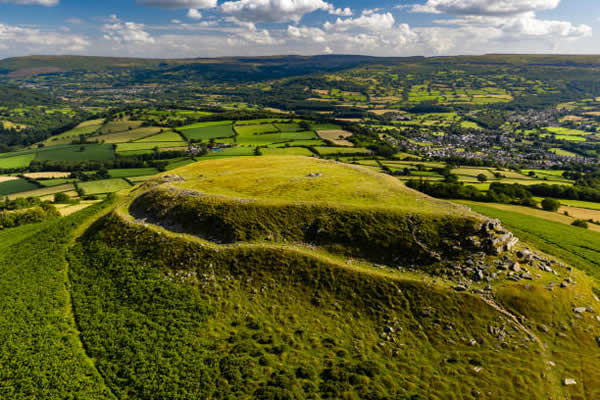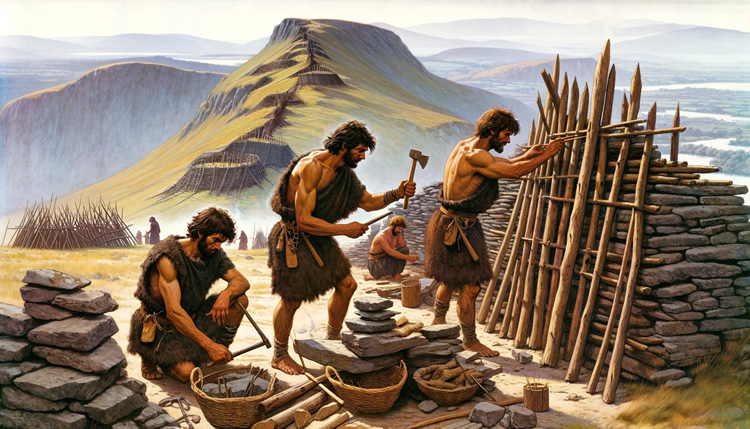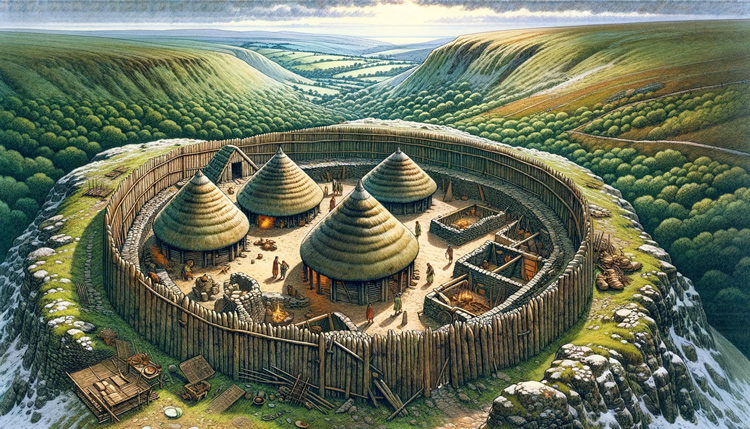Exploring the History of The Iron Age Hillfort of Table Mountain, Crickhowell
Table Mountain, or Crug Hywel, is a site steeped in history and natural beauty. Rising to 451 meters above sea level, this flat-topped hill overlooks the charming town of Crickhowell, offering breathtaking views and a glimpse into the past. The exact duration of occupation on Table Mountain, home to the Iron Age hillfort known as Crug Hywel, is not precisely documented.
A Journey Through Time: Iron Age to Roman Arrival
The Iron Age, a prehistoric period from approximately 800 BC to the Roman advent in Wales around 75 AD, represents a pivotal era where the innovation of iron profoundly transformed daily life. This epoch, often envisioned as a tumultuous time of Celtic tribal warfare, was indeed marked by significant developments in defence as seen in the construction of hillforts. However, these structures served broader purposes than mere military strongholds, as they were the epicentres of thriving communities.
Climate Change and Social Evolution
Circa 1000 BC, Britain’s climate began to mirror today’s, leading to the abandonment of previously fertile upland areas. This environmental change likely heightened competition for the limited arable lowlands, fuelling tensions and conflict between communities. As a result, hilltop settlements became fortified, evolving into the prominent archaeological sites we study today in the Brecon Beacons National Park, with the hillfort on Table Mountain as a distinguished example.
The Structure and Significance of Hillforts
Thought to have been initially constructed around 500 BC, hillforts like the one atop Table Mountain were central to Iron Age society until the Roman occupation. These forts were not simply martial enclosures; they included domestic roundhouses and ancillary structures such as stock pens and granaries. The design of their defences—ditches, banks, and palisades—varied in accordance with the available resources and the landscape’s natural fortifications, such as steep slopes and cliffs. The intricately designed entrances ensured that access to the hillfort was stringently controlled.
The Societal Implications of Hillforts
The establishment of a hillfort required an organised society with skilled labour, indicating a level of societal complexity not always acknowledged for the Iron Age. These hillforts were not purely defensive; they were bustling hubs of political, social, and religious activities and often served as marketplaces. Specialist activities, particularly metalworking, were a hallmark of these settlements, indicating a controlled and serviced local area.
The Enduring Legacy
Today, the hillforts within the Brecon Beacons National Park, including the one on Table Mountain, stand as monuments to the Iron Age’s societal organisation and architectural acumen. While now in ruins, these sites continue to captivate and offer insights into a past where community, trade, and defence were inextricably linked.
A depiction of a hill fort on Table Mountain, Crickhowell circa 800 BC
Cultural Significance
Table Mountain’s Welsh name, Crug Hywel, possibly refers to a local chieftain, underlining the hill’s historical importance. Some theories suggest the name could also relate to the Norman castle mound in Crickhowell, further highlighting the area’s rich past. Regardless of its origins, Crug Hywel remains a symbol of the enduring connection between the Welsh landscape and its ancestral peoples.
Visiting Table Mountain
For those looking to experience the beauty and history of Table Mountain, the ascent begins just outside Crickhowell. The path takes you through open fields and along ancient tracks, offering not only a physical challenge but also a chance to connect with the natural world and reflect on the centuries of human history embedded in the landscape.
A Legacy Preserved
Table Mountain’s enduring presence serves as a reminder of Wales’s rich archaeological and cultural heritage. It invites us to ponder the lives of those who once stood where we stand, looking out over the same valleys and mountains, under the same sky. As we explore these ancient spaces, we walk in the footsteps of history, bridging the gap between past and present.



